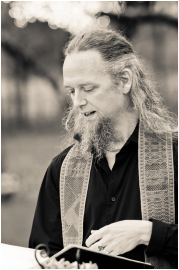Ēostre or Ostara or Ēostre or Ēastre or Ôstara – no matter what you call her, she derives from Proto-Germanic *Austrō, ultimately from a Proto-Indo-European root *h₂ewes- (→ *awes-), "to shine", and therefore closely related to a conjectural name of *H₂ewsṓs, the dawn goddess, which would account for Greek "Eos", Roman "Aurora", and Indian "Ushas". The modern English term "Easter" is the direct continuation of Old English Ēastre.
Alban Eiler is the the first day of spring, or the Vernal Equinox. On my calendar, there are 8 Wheel Days of the year (8 limbs on the path, 8 spokes on the wheel). The four equinoxes and solstices are the Fire Days; the Quarter Days between are the Dark Days. Alban Eiler, which means, "Light of the Earth," is the time that night and day stands equal. Crops are typically sown at this time. The equinoxes and solstices were seen, to the Celts, as a time of transition. This rare balance in nature made these days a powerful time for magic to the ancient Druids.
This season represents beginnings, planting seeds, creating intention – what we plant now will come to fruition and ripen over the next two seasons; what we ‘put away’ for the Winter may now emerge again. Spring officially begins on this day. Indeed, the earth appears to glow with the burgeoning of new life. The tender green of new leaves in the sunlight creates a bedazzlement, a fecundity that we are not accustomed to during the past season. Alban Eiler is associated with the "Rites of Spring," which had to do with the fertility of both plant and animal life.
The celebrations at the vernal equinox anticipated or celebrated the first plowing of the fields, which signified the land’s annual resurrection from the long, cold sleep of winter, inaugurating a new season of fertility. Homes, lanterns, hearths and children were all given a renewed blessing with earth. Crossing the forehead with soil as a symbol of one's connection with the earth was one way of enacting this.
Household animals were often led out to wooded hills to drink from freely flowing springs. This was done to cleanse and strengthen them, symbolically, for the summer’s work. So, we should look at last night’s storms and rain as the cleansing of the season, the freely flowing water that we will so desperately need as we move through the following seasons. The green we have now is the promise of the fertility that waits.
As at all the equinoxes and solstices, there is a rare balance in nature made this day a powerful time of magic for the ancient Druids. From this day forward the forces of light wax and the forces of darkness wane, but on this day they are equally balanced, poised on the razor’s edge. Alban Eiler is a between time, one of the eight portals of the seasons, during which we may more easily move from this world into other realms.
Birds nest and lay their eggs and symbolize for us the egg which has been within the goddess growing since Midwinter. The eggs of birds are colored and eaten in celebration of the emergence of the Son from the womb of the goddess on this day. This is a time of balance, sexual awakening (watch out Gurus and unscrupulous female students!) and fertility -- the planting of spring flowers is an excellent sign of understanding and a safe way to express those feelings.
And, in honor of my soul sista, Sadie Nardini - what post would be complete without something about the Hare, the Bunny, the venerable Rabbit? Well, the púca (or pooka, phouka, puca, púka) is one of the Old Irish spirits long connected with Alban Eiler. In its most ancient, mystical guise, the púca was either a man transformed into rabbit form or else a rabbit transformed into the likeness of a man.
The púca has now been demonized in Christian mythology (in the face of hemophagy, cannabalism and human sacrifice, Bunnies are an anathema!), but before that it was known as the consort of the Fair Lady of the Vernaltides (he was the boyish lover of the goddess). The púca was a spirit servant who acted as a helper in bringing the powers of the Vernaltides to presence in field, garden and wood. In some stories, the púca acts as the boon companion spirit of the Irish Earth Goddess Tailtiu as the vernal equinox approaches.
Rabbits are an old Celtic icon of the fertility of the land. Rabbits have been symbolic of the potency of life in many pagan traditions. To have a rabbit living near where you live is to be reminded, day by day, of the ancient goddess. It was said that if you fed rabbits near your door, benevolence would come and visit you over the course of the summer months.
So, plant seed, plant flowers, play with bunnies, get balanced, clean out the old, make fertile fields furrowed and give thanks and praise!



